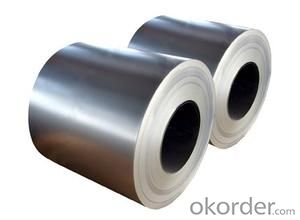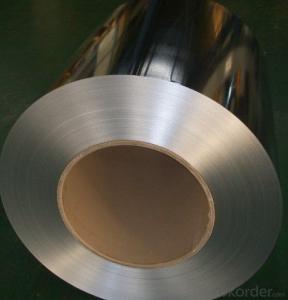Galvanized Steel Strips for Galvanized Steel Pipe (ERW) in Building, Furniture
- Loading Port:
- Shanghai
- Payment Terms:
- TT or LC
- Min Order Qty:
- 25 m.t.
- Supply Capability:
- 10000 m.t./month
OKorder Service Pledge
OKorder Financial Service
You Might Also Like
Introduction
Hot roll base hot-dip galvanized steel coil (HGI)
Cold roll base hot-dip galvanized steel coil (CGI)
The continual hot roll steel coil is made into galvanized steel coil by means of passing through the molten zinc pot. The coating on the product surface is characterized by its uniformity, tightness, erosion resistance and pressure resistance. In addition, the strength of the welding seam is satisfied. The product is widely applied in industries such as construction, home electrical appliance, automotive and machine, etc.
Description
Grade: Q195,DX51D+Z;
Standard: JIS G 3302, EN10327, ASTM A653, GB 2518;
Thickness: 0.24mm – 2.5mm; Width:30-1250mm; Coil ID: 508mm;
Process of Cold Rolled Steel Tape: Rolling-Annealing-Dip Coating-Straightening-Coiling
Specifications
High durable in different environment
Best quality for anti-corruption
Easy for operation
Application
With excellent cold bending molded manufacturablity, good decoration effect, strong anti-corrosion ability, galvanized steel coils and sheets are also pollution-free and easily recycled. Accordingly, they can be used as final products and basic plates of color coated steel coils and widely applied in construction, home appliances,decoration, ect.


- Q:I want to get a new knife but i cant decide if i wan a spyderco pacific salt or a cold steel ak47
- What exactly are you using it for? Personally I would go with Cold Steel AK47. It's a good all around knife for hunting, combat, stabbing and slashing as well as everyday use. Well balanced tip and very little bladeplay which can be a problem with a cheaper knife. Both are good companies but the CS AK47 wins hands down for me.
- Q:How does adding carbon to Iron make it stronger? How does steel look the molecular structure in comparison to Iron? looking for a very scientific answer =]
- Cast Iron' is typically brittle, while 'Maleable Iron' has a small percentage of carbon which allows it to be hammered and formed. Steel is an alloy that consists mostly of iron and has a carbon content between 0.2% and 2.1% by weight, depending on the grade. Carbon is the most common alloying material for iron. Steel is a crystalline structure of iron molecules interspersed with carbon molecules. This is properly known as cementite. The hardness and malleability of steel depends not only on the carbon content, but on how the carbon and iron molecules are arranged to one another. Internal stresses in the steel's crystalline structure will increase or decrease depending on the temperature it is subjected to and the rate at which molten steel is cooled. This 'tempering' can increase the strength of the steel at the expense of brittleness.
- Q:How are steel coils used in the manufacturing of suspension systems?
- Steel coils are used in the manufacturing of suspension systems as they provide the necessary support and cushioning for vehicles. These coils, also known as coil springs, are placed between the vehicle's chassis and the wheels to absorb impact and ensure a smooth ride. The steel coils are designed to compress and expand under the weight and movement of the vehicle, effectively absorbing shocks, vibrations, and uneven road surfaces. This helps to improve stability, handling, and overall comfort for the driver and passengers.
- Q:What is the standard weight of steel coils?
- The standard weight of steel coils can vary depending on the specific type and dimensions of the coil. However, in general, steel coils typically range in weight from a few hundred kilograms to several metric tons. The weight of a steel coil is primarily determined by its thickness, width, and length. Various industry standards and specifications exist to guide the manufacturing and trading of steel coils, which also include guidelines for determining the appropriate weight range for specific coil sizes.
- Q:How are steel coils used in the manufacturing of industrial compressors?
- Steel coils are used in the manufacturing of industrial compressors as a crucial component for constructing the compressor's internal structure, such as the casing and housing. The steel coils provide strength, durability, and stability to the compressor, allowing it to withstand high pressure and temperature conditions. Additionally, the coils are often used in the construction of the compressor's motor, providing support and ensuring efficient operation. Overall, steel coils play a vital role in the manufacturing of industrial compressors by providing the necessary structural integrity and functionality.
- Q:How are steel coils used in the manufacturing of body reinforcements?
- Steel coils are used in the manufacturing of body reinforcements by being shaped and welded to form sturdy structural components, such as pillars, beams, and frames, that provide strength and rigidity to the vehicle's body structure.
- Q:What are the different types of steel coil finishing equipment?
- Various industries utilize a range of steel coil finishing equipment to ensure that steel coils are properly prepared and finished according to the desired specifications. Some commonly used equipment includes: 1. Slitting lines, which cut large steel coils into narrower strips using multiple slitting knives at high speeds. These are commonly used in automotive, construction, and packaging industries. 2. Leveling lines, which flatten and straighten steel coils with uneven surfaces or irregularities using leveling rolls and tension control systems. These are commonly used in the manufacturing of appliances, furniture, and metal roofing. 3. Recoiling lines, which rewind steel coils into smaller coils of specific diameter and weight by carefully winding them around a mandrel. These are commonly used in electrical, HVAC, and steel distribution industries. 4. Cut-to-length lines, which cut steel coils into specific lengths as per customer requirements using precision measuring systems and hydraulic shears. These are commonly used in manufacturing, construction, and fabrication industries. 5. Coating lines, which apply protective coatings or finishes on steel coils to enhance corrosion resistance, durability, and appearance. These lines typically consist of cleaning and pre-treatment sections, followed by coating application sections. They are commonly used in automotive, appliances, and construction industries. These examples represent just a few of the available types of steel coil finishing equipment. Each type serves a specific purpose and plays a crucial role in the manufacturing and processing of steel coils for various applications.
- Q:I am a beginner (never played before!) and I am going to try to teach myself since I think it is a lovely instrument. I am fourteen-years-old so I am not 'adult-size', haha. Anyway, what is difference between nylon strings and steel strings?Thanks :)
- Make your choice based on the type of music you intend to play. Nylon strings are used primarily for classical, flamenco and folk music. Steel strings are used for pop, rock, blues, country, folk, bluegrass.... Both types of guitar are tuned the same, so you *can* play any style of music on either guitar. The big difference is in the tone. Nylon strings are rich and full...if perhaps a little mellow. Steel strings are twangy and have a bite to the sound. There are differences in the construction and feel of the guitars, but that's not critical to your decision. Match the guitar to the music you intend to play. At 14 yrs old, you are certainly big enough for a full sized guitar....and I'll bet you're still growing, right? Even full sized guitars still vary in the size of the body. Try a few out to see how well they fit your reach.
- Q:What are the different methods of perforating steel coils?
- There are several methods used for perforating steel coils, each with its own advantages and applications. 1. Mechanical Punching: This is one of the most common methods used for perforating steel coils. It involves using a mechanical press to punch holes in the coil using a punch and die set. The size and shape of the holes can be customized based on the design of the punch and die set. Mechanical punching is efficient and can produce high-quality holes with consistent results. 2. Laser Cutting: Laser cutting is a popular method used for perforating steel coils, especially when complex hole patterns or intricate designs are required. It involves using a high-powered laser beam to cut through the steel coil, creating precise and clean holes. Laser cutting offers flexibility in terms of hole size, shape, and spacing, and it can be computer-controlled for precise and repeatable results. 3. CNC Plasma Cutting: This method involves using a high-velocity plasma jet to cut through the steel coil and create perforations. CNC (Computer Numerical Control) technology is used to guide the plasma cutter, enabling precise and accurate hole patterns. CNC plasma cutting is ideal for thicker steel coils and can produce larger holes compared to laser cutting. 4. Waterjet Cutting: Waterjet cutting uses a high-pressure jet of water mixed with an abrasive material to cut through the steel coil. This method offers versatility in terms of hole size, shape, and material compatibility. Waterjet cutting is known for its ability to produce intricate and precise perforations without heat-affected zones or distortion. 5. Electrical Discharge Machining (EDM): EDM is a method that utilizes electrical discharges to erode the material and create perforations in the steel coil. It involves using a conductive electrode and a dielectric fluid to generate controlled sparks that remove material and form holes. EDM can be used to create complex shapes and patterns and is particularly suitable for hard materials. The choice of method depends on factors such as the desired hole size and shape, the thickness and type of the steel coil, the required precision, and the production volume. Each method has its own advantages and limitations, and it is important to select the most appropriate method based on the specific requirements of the perforated steel coils.
1. Manufacturer Overview |
|
|---|---|
| Location | |
| Year Established | |
| Annual Output Value | |
| Main Markets | |
| Company Certifications | |
2. Manufacturer Certificates |
|
|---|---|
| a) Certification Name | |
| Range | |
| Reference | |
| Validity Period | |
3. Manufacturer Capability |
|
|---|---|
| a)Trade Capacity | |
| Nearest Port | |
| Export Percentage | |
| No.of Employees in Trade Department | |
| Language Spoken: | |
| b)Factory Information | |
| Factory Size: | |
| No. of Production Lines | |
| Contract Manufacturing | |
| Product Price Range | |
Send your message to us
Galvanized Steel Strips for Galvanized Steel Pipe (ERW) in Building, Furniture
- Loading Port:
- Shanghai
- Payment Terms:
- TT or LC
- Min Order Qty:
- 25 m.t.
- Supply Capability:
- 10000 m.t./month
OKorder Service Pledge
OKorder Financial Service
Similar products
New products
Hot products
Related keywords





























